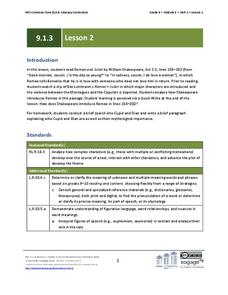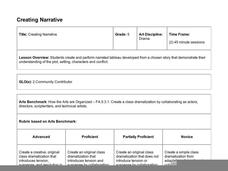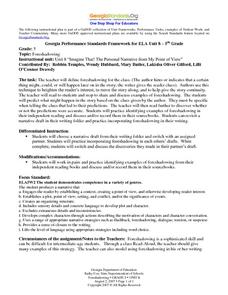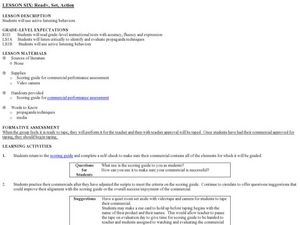Star Wars in the Classroom
"Shakespeare and Star Wars": Lesson Plan Day 11
Class members take center stage as groups perform scenes from Ian Doescher's William Shakespeare's Star Wars: Verily, A New Hope. Actors are encouraged to add stage directions to the script, as well as create costumes and props to...
Curated OER
Characters in Live Performance
Your intermediate or advanced thespians choose dramatic scenes to perform in duos, small groups, or solo to demonstrate vocal and physical characterization. Use class time to prepare and rehearse. Detailed rubrics work for peer assessment.
PBS
Supernatural Shakespeare and Macbeth
"A drum, a drum! Macbeth doth come." The withered and wild witches of Shakespeare’s Scottish play launch an examination of the fantastical elements in Act I, scene iii, paying particular attention to the action, imagery,...
EngageNY
Grade 9 ELA Module 1: Unit 3, Lesson 17
Romeo and Juliet, Act 5, Scene 3, lines 139-170, is the focus of this day's lesson plan. Readers examine the dramatic irony in Juliet's comments and consider how "lamentable chance" caused by a "greater power" plays a role in the tragedy.
EngageNY
Grade 9 ELA Module 1: Unit 3, Lesson 2
After viewing a clip from Baz Luhrmann’s Romeo + Juliet in which major characters are introduced, and the violence between the Montagues and the Capulets is depicted, the class reads Act 1, Scene 1, lines 158-202. Groups then analyze the...
Hawaiʻi State Department of Education
Characters from a Box
Character analysis is a skill we use when we read literary works or want to write a good story. Learners will use drama to practice character analysis while focusing on the details that make characters act the way they do. They'll each...
Hawaiʻi State Department of Education
Creating Narrative
Plot, setting, characters, and conflict are common to both drama and narrative stories. Kids create narrated tableaus that show their understanding of the plot, setting, and conflict of a story they've recently read. The lesson...
Curated OER
Foreshadowing
Students read and discuss Act V, Scene 1. They define foreshadowing and identify examples of it from the text. They edit a partner's diary entry. They identify key ideas from the scene.
Curated OER
Rather Cut a Little
Students create podcasts of Measure for Measure. In this Measure for Measure lesson plan, students decide which lines are the most important and edit scenes to create a shorter version of the play that includes the important...
Curated OER
Ready, Set, Action!
Fifth graders explore sequential dramatization through children's literature. In this drama activity, 5th graders act out and record scenes using digital and video cameras. Students create a digital poster using pictures from their...
Curated OER
Ancient Greece Podcast
In this writing a podcast lesson plan, 7th graders create a podcast involving Ancient Greece. Middle schoolers follow a rubric and outline to create their podcast. Students present their podcast to their fellow middle schoolers.
Curated OER
Macbeth Madness
Students analyze Shakespeare's Macbeth in a variety of creative activities. In this Macbeth lesson, students read Act Two, Scene IV and Act Three, Scene I-VI. Students then complete the text given at the link.
Curated OER
Conspiracy after the Storm: Editing Dual Murder Plots in Shakespeare's 'The Tempest'
Students edit scenes from Shakespeare's The Tempest in documentary fashion and perform their edited scripts. In this play analysis lesson plan, students read through Act 2 and 3 and discuss how and why to cut lines in a play. Students...
Curated OER
Macbeth Madness
Students analyze Shakespeare's Macbeth by completing the creative activities. In this Macbeth lesson, students discuss the timeline for William Shakespeare and identify the characters for Macbeth. Students read Act One, Scenes i-v of...
Curated OER
Macbeth Madness
Students analyze Shakespeare's Macbeth. In this Macbeth lesson, students read Act Two Scene iv and Act Three Scenes i-vi in the play and complete the test from the given link.
Curated OER
Editing the Conspiracy: Julius Caesar
Students practice close reading skills to edit the text of Julius Caesar as they read. They identify the features of the conspiracy. They discuss use of image of dark and light in the text.















